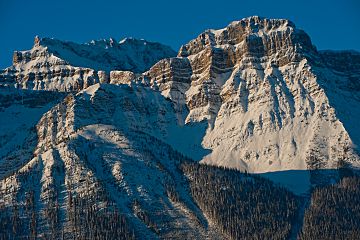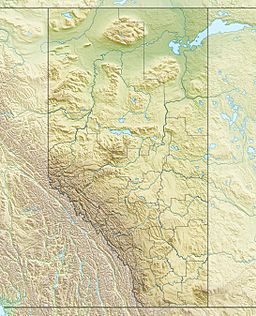Pulpit Peak facts for kids
Quick facts for kids Pulpit Peak |
|
|---|---|

Pulpit Peak & N. Shoulder from Icefields Parkway
|
|
| Highest point | |
| Elevation | 2,720 m (8,920 ft) |
| Prominence | 140 m (460 ft) |
| Parent peak | Lilliput Mountain (2925 m) |
| Listing | Mountains of Alberta |
| Geography | |
| Location | Banff National Park Alberta, Canada |
| Parent range | Waputik Range Canadian Rockies |
| Topo map | NTS 82N09 |
| Geology | |
| Age of rock | Cambrian |
| Type of rock | Sedimentary |
| Climbing | |
| Easiest route | Scramble |
Pulpit Peak is a cool mountain in Banff National Park, Alberta, Canada. It stands tall at 2,720-metre (8,920-foot) (about 8,924 feet) and is located near Hector Lake. This peak is part of the Canadian Rockies.
Pulpit Peak is close to Lilliput Mountain, which is even taller. You can see Pulpit Peak from the Icefields Parkway. It rises about 900 metres (2,950 ft) (2,953 feet) above Hector Lake. It's also part of the Waputik Mountains.
How Pulpit Peak Got Its Name
Pulpit Peak got its name in 1898. A person named Charles Sproull Thompson named it. He was an explorer who climbed many mountains in the Canadian Rockies.
Thompson thought the mountain looked like a pulpit. A pulpit is a raised platform in a church where a speaker stands. The name was officially accepted in 1924.
What Pulpit Peak is Made Of
Like other mountains in Banff National Park, Pulpit Peak is made of sedimentary rock. This type of rock forms from layers of sand, mud, and shells. These layers built up over millions of years.
The rock was laid down during the Precambrian to Jurassic periods. This means it formed a very long time ago in shallow seas. Later, during an event called the Laramide orogeny, these rocks were pushed up. This pushing and folding created the mountains we see today.
Weather at Pulpit Peak
Pulpit Peak is in a subarctic climate zone. This means it has very cold, snowy winters. Summers are usually mild. Temperatures can drop below -20 °C (which is -4 °F). With wind, it can feel even colder, below -30 °C (-22 °F).
The snow and rain that fall on Pulpit Peak drain into the Bow River. The Bow River is a part of the larger Saskatchewan River system.



